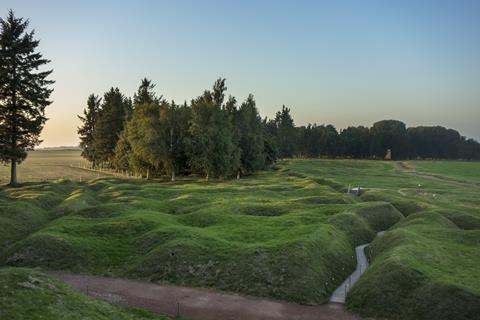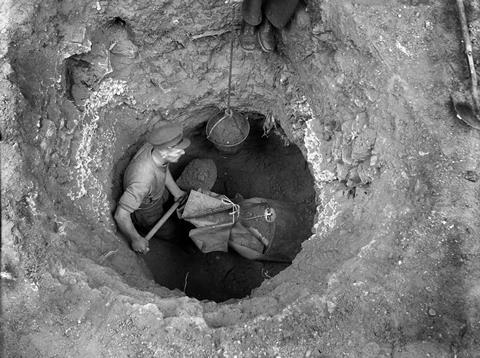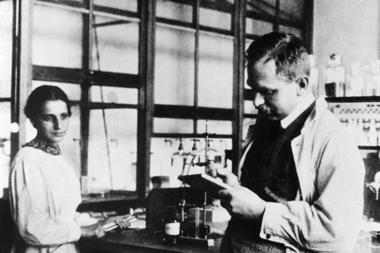A century after the end of the first world war, the task of disposing of old chemical weapons continues. Michael Freemantle reports
On 11 November 1918, the guns finally fell silent as the armistice came into effect, ending world war one. Chemical weapons, first launched on 22 April 1915 by German gas troops supervised by Fritz Haber, had been used for more than three years. The weapons caused immense carnage and suffering but had little impact on the outcome of the war. They helped the Germans more than the Allies, but they ‘did not win them a battle, let alone give them victory’, wrote Haber’s son, Lutz.1 He concluded that chemical warfare was ‘largely a waste of effort’.
The end of the conflict marked the beginning of the work to clean up after this wasted but deadly effort. The ongoing process to dispose of the old weapons that remain has proved complex, dangerous and costly. And it will continue for many years to come.
Millions of tons
On 21 February 1916, German artillery fired 100,000 shells in the first hour of its attack on French defences at Verdun. During the 303-day battle, the two armies bombarded each other with an estimated 23 million shells. Many of the shells, both French and German, contained phosgene. On 11 July alone, the Germans fired 75,000 phosgene shells containing some 137 tons of the lethal chemical.
Sulfur mustard appeared on the western front the following year. One night in July, the Germans bombarded British frontlines east of the Belgian town of Ypres, with 50,000 shells containing around 125 tons of the blister agent.
125 million tons of toxic gases were used
In September 1917, the Germans began firing shells filled with the vomiting agent diphenylchlorarsine. It was designed to force Allied troops to wrench off their gas masks so they could be sick and expose themselves to lethal gases fired in shells at the same time.
Some 66 million gas shells were fired during the war, according to the 1937 estimate of Augustin Prentiss, a lieutenant colonel in the United States Army Chemical Warfare Service.2 He points out that 125 million tons of toxic gases were used, not just in shells, but also in grenades, cylinders, bombs, mines and canisters. Prentiss lists 46 chemical warfare agents used or developed for use in the war.
The end of the war marked the end of the widespread use of chemical weapons in Europe, but not elsewhere. Between December 1935 and April 1936, for example, Italian aircraft dropped several hundred tons of sulfur mustard on Ethiopian forces during the second Italo-Ethiopian war. The action violated the Geneva Protocol for prohibiting the use of poisonous gases in war, which Italy had ratified in 1925. The protocol came into force in 1928.
Chemical weapons can be considered as stockpiled or non-stockpiled, observes Ron Manley, former director of the verification division of the Organisation for the Prohibition of Chemical Weapons. ‘Stockpiled chemical munitions are those produced since the second world war and retained for potential military use,’ he explains. ‘They are generally in good condition, clearly marked and appropriately stored.’ He adds that, since the Chemical Weapons Convention (CWC) came into force in April 1997, around 8.5 million stockpiled chemical munitions have been declared by the member states that are party to the convention. ‘The vast majority have already been destroyed and the few that remain are in the process of being destroyed,’ Manley says.
Non-stockpiled chemical weapons are old or abandoned munitions. The CWC defines old chemical weapons as those produced before 1946 that are no longer useable. Approximately 30% of those fired between 1914 and 1918 did not detonate.3 Retreating German soldiers also left dumps of unused chemical munitions. Most of the old gas shells recovered from battlefields contain phosgene, mustard gas or organoarsenic compounds, according to Manley. An estimated 10 million or more lost or abandoned chemical munitions have yet to be retrieved or destroyed.
An iron harvest
Hundreds of tons of unexploded ordnance are still unearthed by farmers every year in France and Belgium, observes Johannes Preuss, geography professor at Johannes Gutenberg University of Mainz in Germany. ‘In some areas, it is part of everyday work,’ he says. The collection, known as the ‘iron harvest’, includes not only chemical munitions, but also high explosive shells and bombs, bullets, shrapnel and barbed wire.

In France, a specialist munitions-clearing agency collects around 900 tons each year. The most intensive bombardments in the first world war occurred in areas collectively known as the ‘red zone’. The areas are surrounded by a less dangerous ‘yellow zone’. The zones stretch from Lille to Verdun and beyond and cover hundreds of square miles of land.
The bombardments destroyed many villages, making them uninhabitable and the land unusable. The areas became littered with human and animal remains and unexploded ordnance, and their soil polluted with toxic chemicals. The French government rebuilt some of the villages but others, known as ‘villages that died for France’, have not been reconstructed and remain unpopulated. The red zone has many no-go areas where public entry, farming and forestry are prohibited. Much of the disposal work in and around the zone is carried out in secret to avoid alarming the local population. It may take several hundred years to clean up the zone completely.
The Belgian Explosive Ordnance Disposal Company, known as DOVO, collects up to 200 tons of unexploded munitions every year. In Britain, a few old chemical weapons are discovered each year on former testing and training firing ranges. The British government’s Defence Science and Technology Laboratory at Porton Down in Wiltshire is licensed to receive, store and safely dispose of these weapons. It currently has around 1000 munitions in the process of being destroyed.
Munitions that have been buried for many years are usually heavily corroded on the outside, without legible markings, their origins as well as their contents unknown. It was also common practice to use the same type of munition body for both chemical and high explosive munitions. Chemical warfare agents have also been found in partially exploded shells and shell fragments.
Although an old shell or bomb buried in a field, forest or testing site has not exploded, there is always a risk that it will explode when disturbed – even after 100 years or more. ‘Handling these munitions is extremely dangerous as many of them are misfires and the state of the explosive content is unknown,’ says Manley. Since the end of the first world war, hundreds of bomb disposal experts and civilians have died or been injured while handling munitions.
Environmental pollution resulting from damaged or corroded munitions is another hazard. Organoarsenic warfare agents and other toxic compounds have seeped out in many areas, contaminating the soil and surface water. Bullets in shrapnel shells and rifle and machine gun cartridges were mostly made of lead. Percussion caps employed mercury fulminate or lead azide to detonate the propellant in the cartridge. During the war, the British alone manufactured billions of rifle and machine gun cartridges containing these heavy metal pollutants.
Disposal
Soon after the armistice, men, women and children began collecting scrap metal from spent or unexploded munitions that lay on the western front battlefields. Before selling the metal, they emptied explosives and other chemicals from the shells. The practice was lucrative but resulted in many casualties. By the early 1920s, it became common practice for authorities to blow up unexploded weapons. The volume was so great, however, that many were loaded onto ships that were simply sunk into the sea.

Dumping munitions into the sea was seen to be safe and environmentally benign. It was thought that any toxic chemicals that leaked out would be rapidly diluted. In the mid-1950s the British dumped over 120,000 tons of chemical munitions off their coast. Overall, more than 300,000 tons of chemical weapons were dumped in the sea after the second world war. Subsequent investigations revealed that bioaccumulation of arsenic in seafood could be associated with sea-dumped munitions. Chemical weapons have also been pulled out in fishermen’s nets and washed up on beaches around the world, resulting in numerous deaths and injuries.
Sea-dumping was eventually banned under the 1972 London Convention on the Prevention of Marine Pollution by Dumping of Wastes and Other Matter, which came into force in 1975. Nowadays, the risk to the marine environment is considered low. The possibility of fishermen and others disturbing the munitions and releasing the chemical agent is still a concern, however. Even so, most authorities advise that old sea-dumped munitions should be left undisturbed, and that marine workers and the general public be advised of their whereabouts so they can be avoided.
Toxic munitions wastes were also burnt in open pits and troughs in the decades after the first world war. The CWC now bans this method of disposal. ‘It requires that all chemical weapons are destroyed in accordance with internationally recognised safety and environmental norms,’ says Manley. About 90% of unexploded ordnance discovered nowadays can be positively identified as conventional. These munitions are traditionally taken with great care to a remote area of land or out to sea and detonated in controlled explosions.
However, it is not always possible to determine the type of munition. ‘The standard practice in this case is to x-ray the munition with it propped at an angle of 45° in a suitably designed facility,’ says Manley. ‘This enables the internal structure of the munition to be examined and information on the likely content determined.’ It reveals, for example, the location of explosives in the munition and presence, if any, of a liquid chemical warfare agent.
‘One needs to know if the munition is fuzed, and if so, how much of a safety problem the fuze is,’ says John Hart, head of the chemical and biological security project at the Stockholm International Peace Research Institute in Sweden. He explains that picric acid fuzes are highly unstable. Such munitions may have to be exploded in situ.
Chemical warfare agents such as sulfur mustard were loaded into munitions as liquids. So, if a liquid is present, the x-ray will show its surface also sloping at 45°. The elemental composition of munition contents can be determined by portable neutron activation analysis instruments.

The instruments avoid the need to open the munition. Other devices have been developed that enable samples of munition contents to be collected without releasing them to the atmosphere. The samples are then subjected to mass spectrometry and other analytical techniques.
Once the contents of the munition have been identified, the chemical agent is traditionally separated from the explosives and munition body. This is achieved by either drilling into the munition or cutting it open. The chemicals are then extracted and destroyed chemically, by hydrolysis for example, or by using a thermal process such as pyrolysis or high temperature incineration.
Phosgene readily hydrolyses in aqueous solutions of sodium hydroxide to form sodium carbonate and sodium chloride. It is therefore relatively easy to destroy. Sulfur mustard, on the other hand, is insoluble in water. Hydrolysis can be achieved by dissolving it in an organic solvent such as ethanol and adding it to a dilute alkaline solution. The products of the reaction are hydrochloric acid and thiodiglycol. Under certain conditions, however, old sulfur mustard forms a gel or crusty solid that cannot be treated in this way. In this case, it must be incinerated.
The explosive contents of a munition are also destroyed by incineration. The metal parts of the munition are decontaminated by heating them to a high temperature in a furnace. The emissions from these furnaces are passed through a pollution abatement system before being released to the atmosphere.
Old munitions containing organoarsenic compounds and soil polluted with spillages of the compounds pose a particular problem. Arsenic-containing material recovered from munitions is converted by oxidation and neutralisation to inorganic arsenic salts such as sodium or calcium arsenate, which are then immobilised in concrete or glass for burial in land.
In Munster, Germany, a plasma arc furnace operating at 15,000°C breaks down organoarsenic material recovered from soil. ‘The inorganic combustion products including the arsenic are absorbed into the molten slag pool,’ explains Manley. The slag is then cast into solid blocks for land burial. The arsenic is bound in silica lattices and does not leach out. The Russians have also used this approach to dispose of stocks of lewisite, an organoarsenic blister agent, and mixtures of lewisite and sulfur mustard.
Explosive containment
Traditional chemical weapon destruction technologies are hazardous and time-consuming as they require disassembly of the munition into its components: toxic agents, explosives and metal parts. The typical daily throughput for such an operation for old chemical weapons at a specialist facility ranges from 10 to 30 munitions, according to Manley. ‘The search for a safer and speedier solution to this problem has, in recent years, seen the development of explosive containment facilities.’
These facilities enable the complete munition, whether conventional or chemical, to be destroyed without the need to separate its components. In April last year, for example, the Belgium Ministry of Defence inaugurated such a facility, Dynasafe’s Static Detonator Chamber, at Poelkapelle, a village near Langemarck.
A specialist facility may be able to process 10 to 30 old chemical weapons a day
An automated loading system feeds chemical, high explosive, incendiary and other types of munition into the detonation chamber which is then heated until the munitions explode and their contents burn. The metal scrap from the chamber is recycled and exhaust gases passed through a pollution control system. The system meets ‘the world’s most stringent environmental regulations’, according to the Swedish company Dynasafe.
The Japanese company Kobe Steel has developed a system ‘for the safe, secure and environmentally compliant disposal of recovered, abandoned or expired munitions’. The system, known as Davinch, an acronym for Detonation of Ammunition in Vacuum Integrated Chamber, has been in operation in Belgium, China, France and other countries for more than 10 years. It can process conventional, chemical and other types of munition.
The destruction facility consists of a multi-walled outer chamber and an inner explosion containment chamber that can be removed if damaged. Explosive charges are placed around the munitions. Detonation of the explosives causes the munitions to implode with a release of heat that destroys the munitions’ chemical components.
Surveying, excavating and finally remediating old and abandoned chemical weapons buried in battlefields, testing grounds and dump sites can be extremely expensive and time consuming. In 1993, for example, construction workers discovered a large quantity of first world war chemical weapons at a former testing site in Spring Valley, Washington DC. The ongoing clean-up of the site has now taken 25 years and cost hundreds of millions of dollars.
Manley points out that all destruction options for old chemical weapons are expensive. Explosive containment facilities are most expensive but, in his view, likely to become the best and safest long term solution to a century-old chemical weapons problem.
Michael Freemantle is a science writer based in Basingstoke, UK, and the author of The Chemists’ War: 1914–1918, published by the RSC in 2014.
References
1 L F Haber, The Poisonous Cloud, Chemical Warfare in the First World War, Clarendon Press 1986, p 280
2 A M Prentiss, Chemicals in War: A Treatise on Chemical Warfare, McGraw-Hill, 1937, p 658
3 J P Zanders in The Challenge of Old Chemical Munitions and Toxic Armament Wastes, Oxford University Press, 1997, p 97













No comments yet